10 Best Agricultural Carbon Offsets (Complete 2024 List)
Impactful Ninja is reader-supported. When you buy through links on our site, we may earn an affiliate commission.
Learn more
Learn more
.
Hey fellow impactful ninja ? You may have noticed that Impactful Ninja is all about providing helpful information to make a positive impact on the world and society. And that we love to link back to where we found all the information for each of our posts. Most of these links are informational-based for you to check out their primary sources with one click. But some of these links are so-called "affiliate links" to products that we recommend. First and foremost, because we believe that they add value to you. For example, when we wrote a post about the environmental impact of long showers, we came across an EPA recommendation to use WaterSense showerheads. So we linked to where you can find them. Or, for many of our posts, we also link to our favorite books on that topic so that you can get a much more holistic overview than one single blog post could provide. And when there is an affiliate program for these products, we sign up for it. For example, as Amazon Associates, we earn from qualifying purchases. First, and most importantly, we still only recommend products that we believe add value for you. When you buy something through one of our affiliate links, we may earn a small commission - but at no additional costs to you. And when you buy something through a link that is not an affiliate link, we won’t receive any commission but we’ll still be happy to have helped you. When we find products that we believe add value to you and the seller has an affiliate program, we sign up for it. When you buy something through one of our affiliate links, we may earn a small commission (at no extra costs to you). And at this point in time, all money is reinvested in sharing the most helpful content with you. This includes all operating costs for running this site and the content creation itself. You may have noticed by the way Impactful Ninja is operated that money is not the driving factor behind it. It is a passion project of mine and I love to share helpful information with you to make a positive impact on the world and society. However, it's a project in that I invest a lot of time and also quite some money. Eventually, my dream is to one day turn this passion project into my full-time job and provide even more helpful information. But that's still a long time to go. Stay impactful,Affiliate Disclosure
Why do we add these product links?
What do these affiliate links mean for you?
What do these affiliate links mean for us?
What does this mean for me personally?
![]()
Agricultural activities (e.g., fertilizers, pesticides, and animal waste) are responsible for roughly 30% of total greenhouse gas (GHG) emissions annually. Partnering agriculture with carbon offsets could have a big impact on mitigating climate change. So, we had to ask: what are the best agricultural carbon offsets?
The best agricultural carbon offsets are offered by Husk, Vi Agroforestry, and Native Energy, which involve biochar, agroforestry, avoided grassland conversion, and methane capture projects across the globe. Carbofex and Novocarbo also repurpose waste and CO2 into biochar and sustainable products.
Keep reading to learn more about the best agricultural carbon offsets, how these carbon offset projects work, what their respective offsetting costs are, and what your best way would be to offset your carbon emissions. At the end of the article, we’ll also share with you what the biggest carbon offsetting limitations are and why reducing your carbon footprint is more effective than offsetting it.
Here’s What All the Best Agricultural Carbon Offsets Have in Common
Carbon offsets are reductions in carbon emissions that are used to compensate for carbon emissions occurring elsewhere. They are measured in tons of carbon dioxide (CO2) equivalents and are bought and sold through international brokers, online retailers, and trading platforms on what is known as the global carbon offset market.
“Carbon Offset: a way for a company or person to reduce the level of carbon dioxide for which they are responsible by paying money to a company that works to reduce the total amount produced in the world, for example by reforestation”
Oxford Dictionary
Agriculture is an industry that ranges from small local farmers to commercial grain and livestock operations. It involves soil, crops, and livestock all working together.
“Agriculture: the science, art, or practice of cultivating the soil, producing crops, and raising livestock and in varying degrees the preparation and marketing of the resulting products”
Merriam Webster Dictionary
Agricultural carbon offsets are a specific type of carbon offset designed to mitigate greenhouse gas (GHG) emissions from agriculture including the addition of fertilizers to soils, manure management, field burning of crop residues, and fuel usage on farms.
“Agricultural carbon credits: increase the storage of carbon from the air into the soil through improved forest, grassland and cropland practices”
Some examples of agricultural practices that can generate carbon offset credits include:
- Agroforestry
- Soil carbon maintenance
- Methane capture from livestock
- Peatland management
- Livestock and manure management
- Nutrient management on cropland and grasslands
And of these practices, some of the most common agriculture carbon offset projects typically involve:
- Biochar: CO2 absorbing-charcoal that is formed when biomass (e.g., crop residue, grass, trees, waste) is combusted in the absence of oxygen at temperatures of 300–600°C (572-1112°F). It can be tilled into soils, stored in long-lasting products, buried deep underground, or used as an additive for construction, plastics, paper, and textiles.
- Agroforestry: the integration of trees and shrubs into crop and animal farming systems. Alley cropping, forest farming, silvopasture, riparian buffers, and windbreaks are all examples of agroforestry practices.
- Avoided grassland conversion to cropland: grasslands are often identified as key areas for conversion to cropland because they account for 20-40% of Earth’s land area and have rich soils. Protecting this ecosystem is crucial to maintaining biodiversity and its carbon storage capacity.
- Methane (CH4) capture: Agriculture is the predominant source of methane (CH4) emissions, which is 25 times more potent than CO2 at trapping heat in our atmosphere. CH4 capture from livestock and the installation of anaerobic methane digesters for manure conversion and on-farm electricity generation are common agricultural offset projects.
These Are the Best Agricultural Carbon Offsets in 2024
Below are our favorite agricultural carbon offsets (you can click on their link to directly jump to their section in this article):
| Agricultural Carbon Offsets | Quick Facts |
| Husk | About: Husk converts rice husks into biochar, fertilizers, and biopesticides via smokeless pyrolysis, preventing the re-emission of carbon into the atmosphere. Costs: Husk uses resellers to sell its solutions. Visit Patch’s website to learn more about pricing. |
| Vi Agroforestry | About: Vi Agroforestry specializes in poverty reduction and environmental improvement through agroforestry and improved farming practices. Costs: $28 per 1,000kg of CO2 offset |
| Native Energy | About: Native Energy offers a variety of regenerative agriculture carbon offset projects including avoided grassland conversion, farm methane, and soil carbon. Costs: Costs are determined after initial contact. |
| Carbofex | About: Carbofex’s pyrolysis technology takes waste biomass from urban or agricultural sources and turns it into biochar, which can then be used to enhance agricultural soils or to produce renewable energy. Costs: Carbofex uses resellers to sell its solutions. Visit the Puro.earth website to learn more about their respective pricing. |
| Novocarbo | About: Novocarbo uses pyrogenic carbon capture and storage, which converts CO2 into regenerative energy and biochar. The biochar can be used as soil, as a replacement for cement, and in regenerative agriculture. Costs: Novocarbo uses resellers to sell its solutions. Visit the Puro.earth, or Carbonfuture website to learn more about their respective pricing. |
| One Tree Planted | About: Carbon offset purchases support agroforestry projects such as the fruit tree planting project in India, which combats deforestation and plants a variety of fruit trees (banana, peach, pear, guava, mango) to provide farmers with food and income. Costs: $20 per 1,000kg of CO2 |
| Pacific Biochar | About: Pacific Biochar has partnered with biomass power plants to modify their equipment to produce biochar. They take forest biomass from high fire hazard areas in California, US, and turn it into biochar, which is then distributed on agricultural fields or in collaboration with compost yards. Costs: Pacific Biochar uses resellers to sell its solutions. Visit the Carbonfuture website to learn more about their respective pricing. |
| Carbo Culture | About: Carbo Culture converts CO₂ from plants into biochar and stores it permanently underground. Costs: Costs are determined after initial contact |
| Terrapass | About: Terrapasses farm power offset projects involve capturing methane and generating electricity from livestock manure. Costs: $16.51-$17.63 per 1,000kg of CO2 |
| NetZero | About: NetZero uses agricultural residues (e.g., coffee or cocoa husks and shells; sugarcane bagasse; coconut shells and fibers; peanut or cashew shells; palm empty bunches) to produce biochar via pyrolysis. Costs: NetZero uses resellers to sell its solutions. Visit the Puro.earth website to learn more about their respective pricing. |
Husk: Biochar-Based Fertilizers
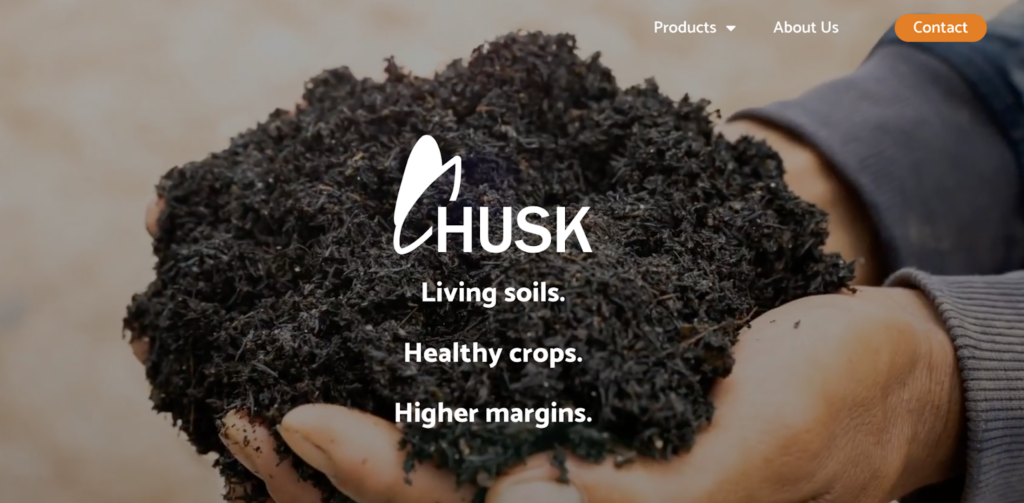
Husk was founded in 2017 by Heloise Buckland and Carol Rius based on the idea that the private sector can combat social inequality and tackle climate change. To date, they have sequestered over 750 tons of carbon on their mission to create a world with living soils, healthy crops, fair wages, and climate justice.
“Living soils. Healthy crops. Higher margins”
Husk
Project overview: Husk converts rice husks into biochar, fertilizers, and biopesticides via smokeless pyrolysis, preventing the re-emission of carbon into the atmosphere. When biochar-based fertilizers are spread on crops, the sequestered carbon within the products is buried into the soil where it will remain for hundreds of years. The process generates carbon credits that are sold to individuals and businesses looking to lower their carbon footprint.
Carbon offset effectiveness: Husk’s biochar plant follows European Biochar Certification (EBC C-Sink) standards, one of the highest standards for carbon removal.
Carbon offset costs: Husk uses resellers to sell their solutions. Visit Patch’s website to learn more about pricing.
How to get your carbon offsets: You can get your Husk biochar carbon offsets through the Patch website.
Vi Agroforestry: Tropical Agroforestry
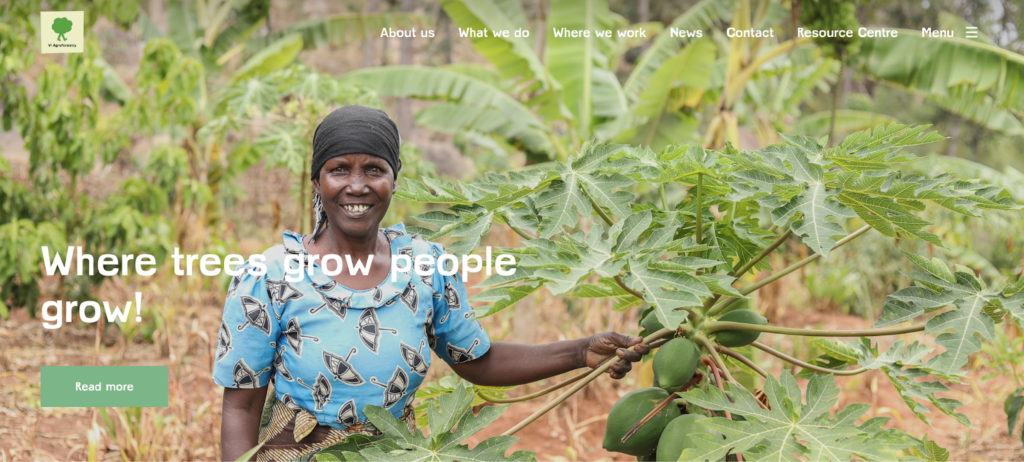
Vi Agroforestry is a Swedish development organization founded in 1983 initially as a tree planting organization. Today, they work with local partners in East Africa to provide agricultural development projects aimed at improving livelihoods.
“For climate and people, now.
” Vi Agroforestry
Project overview: Vi Agroforestry specializes in poverty reduction and environmental improvement through agroforestry and improved farming practices. They currently operate in Kenya, Rwanda, Tanzania, and Uganda. Their Kenya Agriculture Carbon Project (KACP) is the first soil and agricultural carbon project in Africa, which helps 30,000 farmers battle food security and combat climate change. Carbon credits generated from the project benefit small-holder farmers.
Carbon offset effectiveness: The KACP is certified by the Verified Carbon Standard.
Carbon offset costs: It costs approximately $28 per 1,000kg of CO2 offset.
How to get your carbon offsets: You can visit their website to calculate your carbon footprint and get your carbon offsets.
Native Energy: Changing the World Through Climate Projects
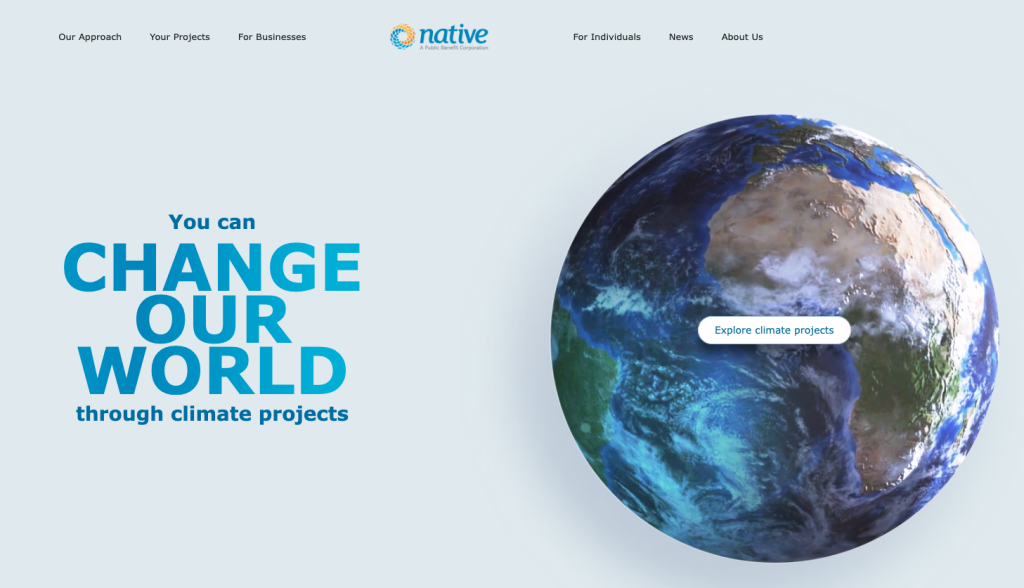
Native Energy was founded in 2000 by Jeff Bernicke as a platform for organizations to implement projects that reduce greenhouse gas emissions and combat climate change.
Today, they offer carbon offsets and renewable energy solutions that provide clients the opportunity to invest and enable the development of new climate projects with direct business benefits.
“Envision your ideal climate solution. Let us build it.”
Native
Carbon offset credit overview: Native Energy offers a variety of regenerative agriculture carbon offset projects including those in Kenya, Canada, Brazil, and the US. For example, their May Ranch Avoided Grassland Conversion Project protects grassland ecosystems, their Northern Kenya Rangelands Project is a landscape-scale soil carbon project, and their Noblehurst Family Farm Project is a farm methane power project.
Carbon offset credit effectiveness: Native Energy’s offsets are certified by one of the following leading standards: Gold Standard, Verified Carbon Standard, Climate Action Reserve, American Carbon Registry, Plan Vivo, Climate, or the Community & Biodiversity Alliance.
Carbon offset costs: Costs are determined after initial contact.
How to get your Carbon offsets: You can visit their website to learn more and contact a team member to get your agricultural carbon offsets.
Carbofex: Converting Waste Biomass Into Biochar
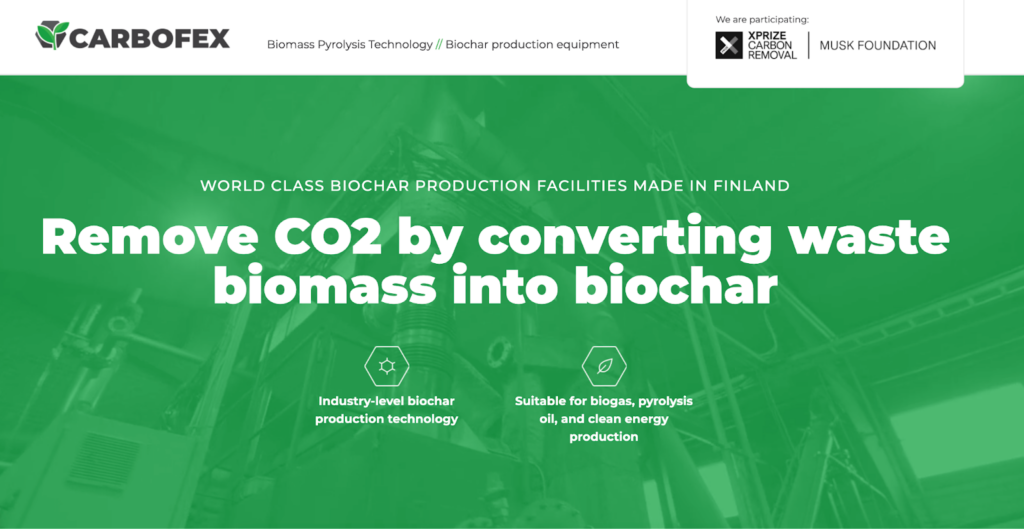
Carbofex is a Finnish biochar company founded in 2016 by Sampo Tukiainen and Veikko Kantero to lower atmospheric CO2 levels long term. Today, they have captured almost 10 million kg of CO2, which equals the carbon footprint of over 2,000 average citizens.
“Unique, state-of-art, turnkey solution for biochar and bio-energy co-production”
Carbofex
Project overview: Carbofex’s pyrolysis technology takes waste biomass from urban or agricultural sources and turns it into biochar, which can then be used to enhance agricultural soils or produce renewable energy. Through this process, Carbofex generates carbon credits certified that are then sold through the Puro.earth trading platform. Each kg of biochar they produce is capable of binding approximately 3.5 kg (7.7 lbs) of CO2 to the soil.
Carbon offset effectiveness: Carbofex’s process complies with the European Biochar Consortium (EBC) standard. And to be listed on Puro.earth, Carbofex also had to undergo third-party independent verifiers who audit carbon removal project facilities and issue CO2 Removal Certificates (CORCs).
Carbon offset costs: Carbofex uses resellers to sell their solutions. Visit the Puro.earth website to learn more about their respective pricing.
How to get your carbon offsets: You can get your Husk biochar carbon offsets through the Puro.earth website.
Novocarbo: Repurposing CO2 Into Sustainable Products
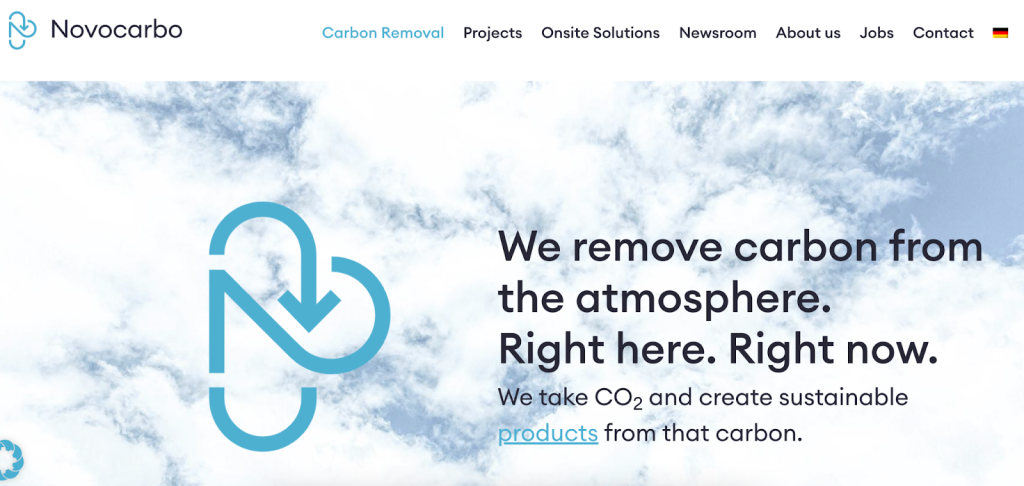
Novocarbo has been capturing CO2 in biochar since 2018, and today they offer one of the first scalable carbon removal solutions on the European market. Their mission is to remove CO2 from the atmosphere now because our climate can’t wait.
“Because we can scale anywhere”
Novocarbo
Project overview: Novocarbo uses pyrogenic carbon capture and storage (PyCCS), which converts CO2 into regenerative energy and biochar, thereby locking away the carbon for thousands of years. Biochar can be used as soil, as a replacement for cement, and in regenerative agriculture. Through this process, Novocarbo generates carbon credits which they sell through the Puro.earth and Carbonfuture trading platforms.
Carbon offset effectiveness: Novocarbo’s process complies with the European Biochar Consortium (EBC) standard. To be listed on Puro.earth, Novocarbon also had to undergo third-party independent verifiers who audit carbon removal project facilities and issue CO2 Removal Certificates (CORCs); and to be listed on Carbonfuture, Novocarbo has to comply with their high standards, including third-party methodology, certification, and auditing.
Carbon offset costs: Novocarbo uses resellers to sell their solutions. Visit the Puro.earth, or Carbonfuture website to learn more about their respective pricing.
How to get your carbon offsets: You can get your Novocarbo offsets through the Puro.earth, or Carbonfuture websites.
One Tree Planted: A Non-Profit Focused On Global Reforestation
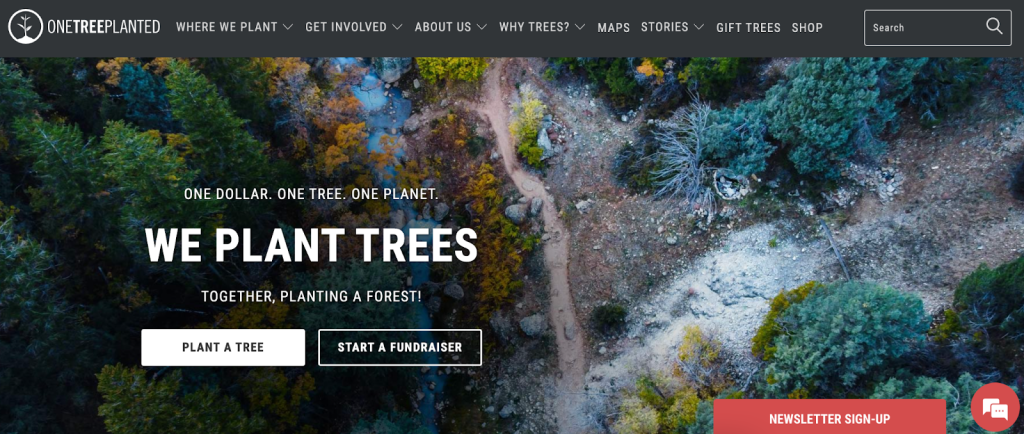
One Tree Planted was founded in 2014 by Matt Hill as a way to make it easier for individuals and businesses to aid in environmental conservation and reforestation across the globe. Today, they have planted over 100 million trees in more than 79 countries.
“One dollar. One tree. One planet.”
One Tree Planted
Carbon offset overview: One Tree Planted is a nonprofit environmental organization that plants trees in North America, Latin America, Africa, Asia, Europe, and the Pacific. An example of an agroforestry project is their fruit tree planting project in India. The project combats deforestation and plants a variety of fruit trees (banana, peach, pear, guava, mango) to provide farmers with food and income.
Carbon offset effectiveness: One Tree Planted’s offsets are certified by the Climate Action Reserve and are retired on a monthly basis.
Carbon offset costs: One Tree Planted offers 3 offset options at a cost of $20 per 1,000kg of CO2.
How to get your carbon offsets: You can visit their website to view their plans and purchase your carbon offsets.
Pacific Biochar: Leaving a Legacy of Fertile Soil
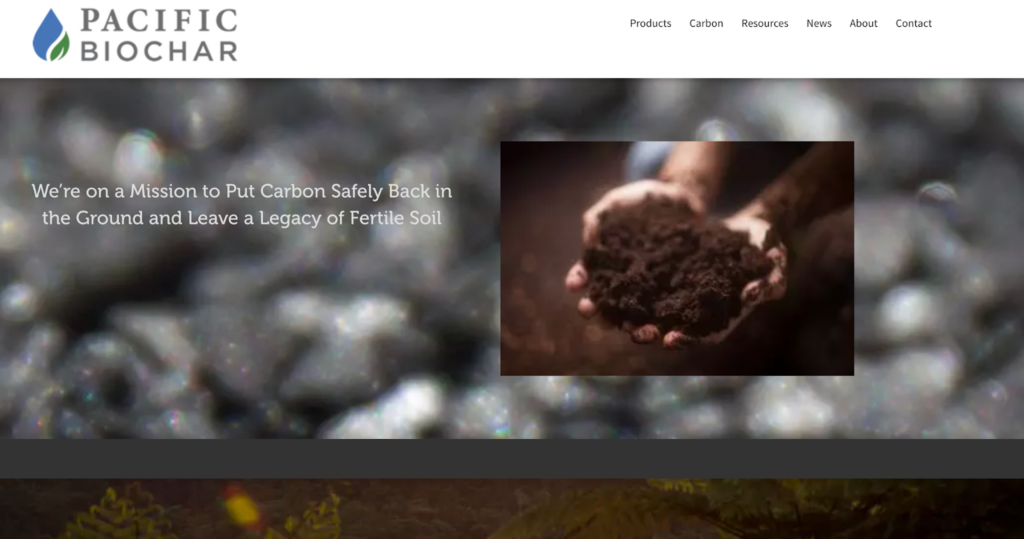
Pacific Biochar was founded in 2014 by Josiah Hunt to mitigate wildfires in California’s feedstock sourcing. Today, their mission is to put carbon safely back in the ground and leave a legacy of fertile soil.
“We put carbon back in the ground, verified, registered, and ready to balance your emissions.”
Pacific Biochar
Project overview: Pacific Biochar has partnered with biomass power plants to modify their equipment to produce biochar. They take forest biomass from high fire hazard areas in California, US, and turn it into biochar, which is then distributed on agricultural fields or in collaboration with compost yards. Through this process, Pacific Biochar generates carbon credits which they sell through the Carbonfuture trading platform.
Carbon offset effectiveness: Pacific Biochcar’s process complies with the European Biochar Consortium (EBC) standard. To be listed on Carbonfuture, Pacific Biochar has to comply with its high standards, including third-party methodology, certification, and auditing.
Carbon offset costs: Pacific Biochar uses resellers to sell their solutions. Visit the Carbonfuture website to learn more about their respective pricing.
How to get your carbon offsets: You can get your Pacific Biochar offsets through the Carbonfuture website.
Carbo Culture: Nature + Engineering to Lock Away Carbon
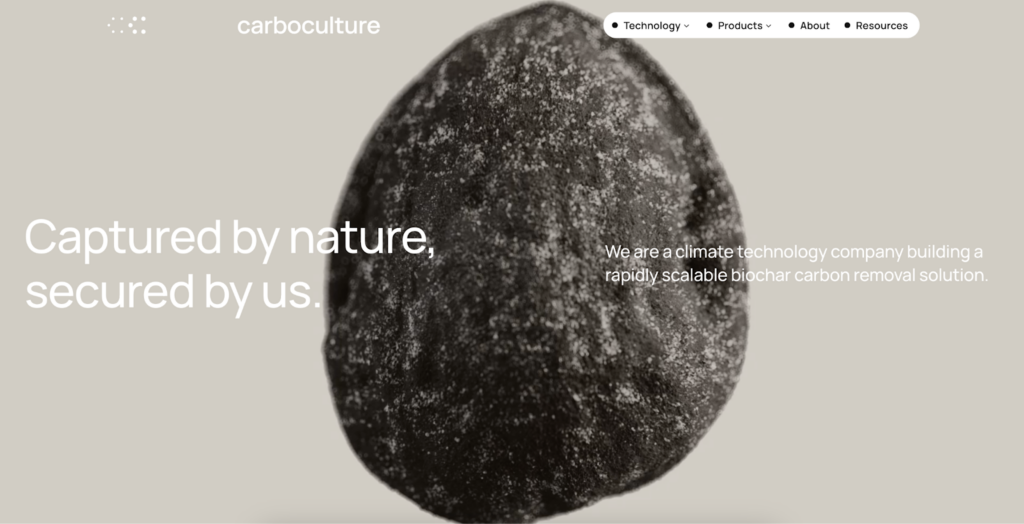
Carbo Culture was founded in 2013 when Henrietta Moon and Chris Carstens first developed a novel carbon removal solution. Today, Carbo Culture is a team of engineers, climate experts and change makers on a mission to remove 1 billion tons of CO2 from the atmosphere.
“Captured by nature, secured by us”
Carbo Culture
Project overview: In the natural carbon cycle, living plants draw down carbon from the atmosphere, and decomposing plants release carbon back into the atmosphere. Carbo Culture’s patented technology, Carbolysis™, hacks this cycle and converts the CO₂ from decomposing plants into biochar, preventing it from being re-emitted into the atmosphere. It can then be stored permanently underground. Carbolysis™ converts agricultural waste into biochar, generates usable heat, and produces carbon credits.
Carbon offset effectiveness: Carbo Culture’s pyrolysis reactor facilities are accredited by Puro.earth, the world’s leading crediting platform for engineered CO2 removal projects.
Carbon offset costs: Costs are determined after initial contact with the Carbo Culture team.
How to get your carbon offsets: You can contact a representative to get your carbon offsets.
Terrapass: Carbon Offsets for Individuals and Businesses
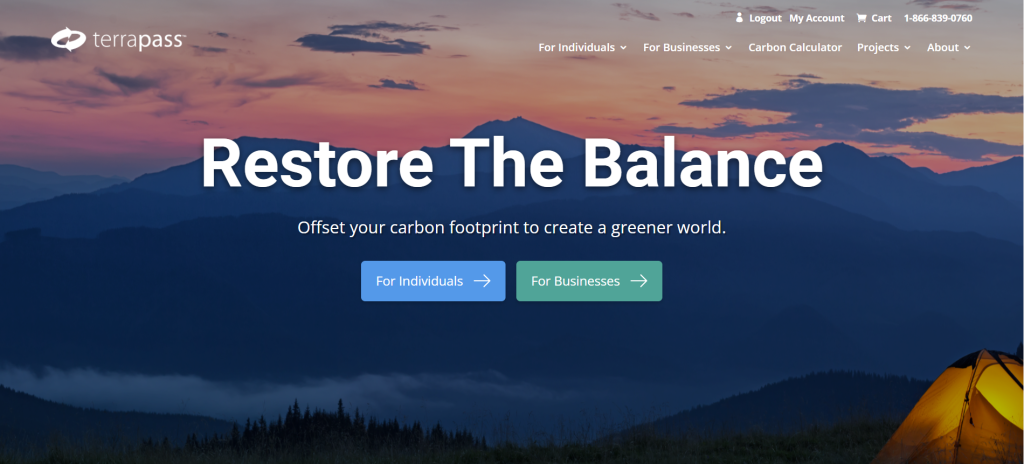
“Restore the balance.”
Terrapass
Project overview: Terrapass rotates through their projects, but they have offered several farm power carbon offsets including the Holsum Elm Dairy, Cottonwood Dairy Organic Waste Digestion Project, Scenic View Dairies, and George DeRuyter and Sons Dairy projects which involve capturing methane and generating electricity from livestock manure.
Carbon offset effectiveness: Terrapasses farm power offsets are certified by the Climate Action Reserve.
Carbon offset costs: Individual carbon offsets range from $16.51-$17.63 per 1,000kg of CO2, and business carbon offsets cost approximately $16.99 per 1,000kg of CO2.
How to get your carbon offsets: You can visit their website to learn more about their farm power projects and then purchase your carbon offsets either as an individual or a business.
NetZero: Biochar Carbon Removal
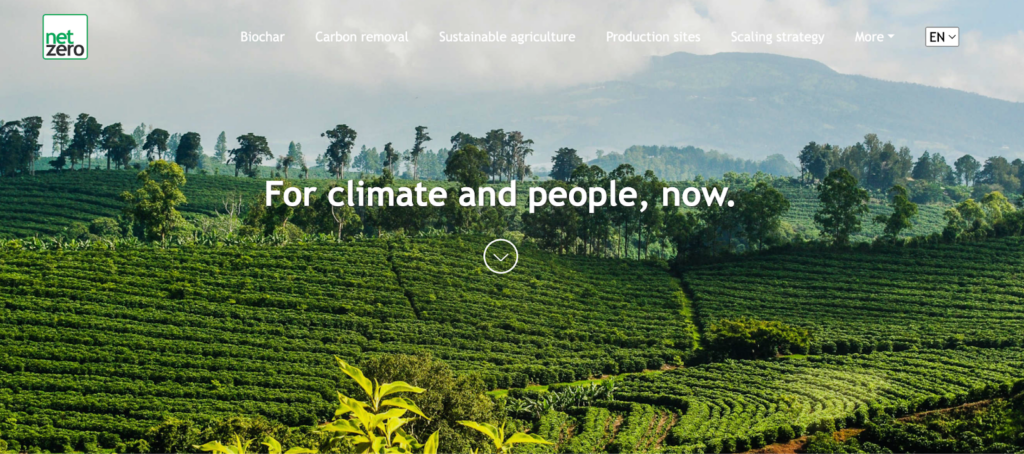
NetZero is a French start-up founded in 2021 by Axel Reinaud, Olivier Reinaud, Pedro de Figueiredo, Aimé Njiakin as a way to scale biochar in tropical regions. Today, they convert agricultural residues into biochar.
“For climate and people, now.”
NetZero
Project overview: NetZero only uses agricultural residues (e.g., coffee or cocoa husks and shells; sugarcane bagasse; coconut shells and fibers; peanut or cashew shells; palm empty bunches) to produce biochar via pyrolysis. They currently have two operational sites, a pilot plant in Cameroon and a commercial factory in Brazil. Their process generates carbon credits certified and sold through the Puro.earth trading platform.
Carbon offset effectiveness: NetZero is a certified carbon-removal project under Puro.earth Standard, the world’s leading crediting platform for engineered carbon dioxide removal projects.
Carbon offset costs: NetZero uses resellers to sell their solutions. Visit the Puro.earth website to learn more about their respective pricing.
How to get your carbon offsets: You can get your NetZero offsets through the Puro.earth website.
How Effective and Efficient Are Agricultural Carbon Offsets
In terms of effectiveness, agricultural carbon offsets can store carbon for long periods of time, protect soil health, and reduce methane (CH4) emissions. However, they can be difficult to monitor and verify, and they do not reduce your own carbon emissions, which can lead to greenwashing.
In terms of efficiency, agricultural carbon offsets are relatively cost-effective; however, they are also not yet scaled to compensate for our global emissions and face storage capacity limitations.
Agricultural carbon offsets are effective at mitigating climate change because:
- Biochar tilled into soils and not disturbed can store CO2 for centuries to millennia, making it a long-term carbon sequestration solution.
- Biochar, agroforestry, and avoided grassland conversion can improve soil structure, soil water-holding capacity, and nutrient cycling.
- CH4 capture from livestock and the installation of anaerobic methane digesters for manure conversion and on-farm electricity generation help prevent CH4 from entering our atmosphere
However, agricultural carbon offsets can also lack effectiveness because agricultural emissions themselves are difficult to measure and manage, and because purchasing a carbon offset does not directly reduce your carbon footprint. It only makes others reduce their carbon footprint to compensate for your carbon footprint.
Agricultural carbon offsets are efficient at reducing CO2 emissions because biochar, agroforestry, CH4 capture, and avoided grassland conversion are relatively cost-effective, averaging less than $40 per ton of CO2 offset.
However, agricultural carbon offsets can also lack efficiency because:
- They are not scaled enough to keep pace with the global GHG emissions of a growing population
- Carbon storage capacity limitations of biochar and agroforestry prevent agricultural offset efforts from compensating for all of our carbon emissions
What Are The 5 Pros and 4 Cons of Agricultural Carbon Offsets
Agricultural carbon offsets can store carbon for long periods of time, protect soil health, reduce methane (CH4) emissions, are cost-effective, and allow us to reduce carbon emissions in ways we wouldn’t be able to accomplish individually.
However, agricultural carbon offsets can also be difficult to monitor and verify, are not yet scaled to compensate for our global emissions, face carbon storage capacity limitations, and do not reduce your own carbon emissions, which can lead to greenwashing.
What Are the 5 Pros of Agricultural Carbon Offsets
Agricultural carbon offsets have various pros that make them effective at reducing carbon emissions.
| 5 Pros of Agricultural Carbon Offsets | Quick Facts |
| #1: Agricultural carbon offsets can store carbon for long periods of time | Experts estimate that biochar tilled into soils and not disturbed can store CO2 for centuries to millennia, making it a long-term carbon sequestration solution. As long as the lands are not developed, the sequestered carbon can remain stored underground. |
| #2: Agricultural carbon offsets protect soil health | Agricultural offsets such as biochar, agroforestry, and avoided grassland conversion can enhance or protect soil health by improving soil structure, soil water-holding capacity, and nutrient cycling. |
| #3: Agricultural carbon offsets reduce methane (CH4) emissions | CH4 capture from livestock and the installation of anaerobic methane digesters for manure conversion and on-farm electricity generation are common agricultural offset projects. They prevent CH4 from entering our atmosphere, and because CH4 is more potent than CO2, removing it is a quick way to slow the rate of global warming, at least in the short term. |
| #4: Agricultural carbon offsets are relatively cost-effective | Agricultural offsets from some leading providers (e.g., Vi Agroforestry, One Tree Planted, and Terrapass) cost less than $40 per ton of CO2 offset. Compare this to direct carbon capture offsets which can cost anywhere from $100-$1,200 per ton of CO2. |
| #5: Agricultural carbon offsets allow us to reduce carbon emissions in ways we wouldn’t be able to accomplish individually | Agricultural offsets such as biochar, agroforestry, CH4 capture, and avoided grassland conversion allow us to reduce emissions from activities where sustainable alternatives are not yet widely available. |
What Are the 4 Cons of Agricultural Carbon Offsets
Understanding the drawbacks of agricultural carbon offsets is important in order to effectively mitigate climate change.
| 4 Cons of Agricultural Carbon Offsets | Quick Facts |
| #1: Agricultural carbon offsets can be difficult to monitor and verify | There are multiple types of agricultural offsets, which can make standardizing, verifying, and monitoring them difficult. Also, we would have to incorporate agricultural offset practices such as biochar, agroforestry, and methane capture on a massive scale and for hundreds of years into the future to exact change on a global level. |
| #2: Agricultural carbon offsets are not yet scaled to compensate for our global emissions | Because agricultural offsets are only a small subsection of the larger carbon offset market, they are also inadequate in terms of offsetting emissions from our global GHG emissions generation. |
| #3: Agricultural carbon offsets face carbon storage capacity limitations | Biochar and agroforestry practices have carbon storage capacity limitations. Studies have shown that too much CO2 in the soil can have negative effects on root water absorption, chlorophyll, starch content, and total biomass. And how much carbon trees can store is dependent on the type of tree and a host of environmental factors, but a typical tree can absorb anywhere from 10-40kg (22-88 pounds) of CO2 per year. |
| #4: Agricultural carbon offsets do not reduce your own carbon emissions, which can lead to greenwashing | If emissions are only offset and not reduced from the source, this could lead to greenwashing, when the consumer is deceived into thinking they are offsetting their emissions but in reality, they are not. |
How Can Agricultural Carbon Offsets Help Mitigate Climate Change
Climate change is a severe and long-term consequence of fossil fuel combustion. Agricultural carbon offsets can help mitigate climate change because they eliminate fossil-fuel-derived carbon from our atmosphere which, if left untreated, can remain there for tens of thousands of years and exacerbate the negative effects of climate change.
How is Climate Change Defined
Climate change is arguably the most severe, long-term global impact of fossil fuel combustion. Every year, approximately 33 billion tons (bt) of CO2 are emitted from burning fossil fuels. The carbon found in fossil fuels reacts with oxygen in the air to produce CO2.
“Climate change: changes in the earth’s weather, including changes in temperature, wind patterns and rainfall, especially the increase in the temperature of the earth’s atmosphere that is caused by the increase of particular gasses, especially carbon dioxide.”
Oxford Dictionary
Atmospheric CO2 fuels climate change, which results in global warming. When CO2 and other air pollutants absorb sunlight and solar radiation in the atmosphere, it traps the heat and acts as an insulator for the planet. Since the Industrial Revolution, Earth’s temperature has risen a little more than 1 degree Celsius (C), or 2 degrees Fahrenheit (F). Between 1880-1980 the global temperature rose by 0.07C every 10 years. This rate has more than doubled since 1981, with a current global annual temperature rise of 0.18C, or 0.32F, for every 10 years.
As the 2015 Paris Climate Agreement outlines, we must cut current GHG emissions by 50% by 2030 and reach net zero by 2050.
How Do Carbon Offsets Generally Help Mitigate Climate Change
Levels of carbon in our atmosphere that cause climate change have increased as a result of human emissions since the beginning of the Industrial Revolution in 1750. The global average concentration of CO2 in the atmosphere today registers at over 400 parts per million. Carbon offsets can help prevent these levels from increasing even more.
When you hear the words “carbon offset”, think about the term “compensation”. Essentially, carbon offsets are reductions in GHG emissions that are used to compensate for emissions occurring elsewhere.
Carbon offsets that meet key criteria and verified project standards, are additional and permanent, and are a part of projects that are carried out until the end of their lifespan have the best chance of reducing carbon emissions and therefore reducing climate change.
When we offset CO2 we also slow the rate of global temperature rise, which in turn minimizes the effects of climate change.
How Do Agricultural Carbon Offsets Specifically Help Mitigate Climate Change
Agricultural carbon offsets such as biochar, agroforestry, avoided grassland conversion, and farm methane can specifically help mitigate climate change because they all aim to reduce CO2 emissions, albeit via different pathways. They can also act as permanent carbon sequestration and reinforce our terrestrial carbon sinks.
For example, according to the Intergovernmental Panel on Climate Change (IPCC), biochar alone could potentially remove up to 2.6 billion tons of CO2 from the atmosphere.
Final Thoughts
The best agricultural carbon offsets are offered by Husk, Vi Agroforestry, and Native Energy, which involve biochar, agroforestry, avoided grassland conversion, and methane capture projects across the globe. Carbofex, Novocarbo, Carbo Culture, Pacific Biochar, and NetZero take advantage of the carbon sequestration properties of biochar. One Tree Planted uses agroforestry methods whereas Terrapass involves capturing methane and generating electricity from livestock manure.
Agricultural offsets sequester CO2 and reduce CH4 emissions, thereby helping to reduce global atmospheric CO2 and CH4 levels. But for all of the good carbon offsets can instigate, they should not be seen as the only solution to climate change. They are effective at reducing GHGs in the short term, but in the long term, they fail to reduce GHGs enough.
When used in conjunction with direct CO2 reduction measures, carbon offsetting can be much more effective. We should reduce our own carbon footprint as much as possible first, and only then choose the most effective agricultural carbon offsets.
Stay impactful,

Sources
- International Atomic Energy Agency: Greenhouse Gas Reduction
- U.S. Environmental Protection Agency: Offsets and RECs -What’s the Difference?
- Britannica: Carbon Offset
- David Suzuki Foundation: Are carbon offsets the answer to climate-altering flights?
- Tristar: Agriculture – An Industry Overview
- University of Nebraska-Lincoln Institute of Agriculture and Natural Resources: Ag Carbon Credits
- World Resources Institute: Everything You Need to Know About Agricultural Emissions
- eAgronom: Different types of carbon offsets in farming you need to know
- US Department of Agriculture: Agroforestry
- American University – The Institute for Carbon Removal Law and Policy: Soil Carbon and Biochar
- Ceezer: How biochar emerged as an unexpected champion in the fight against the climate crisis
- World Wildlife Fund: Why grasslands are so important
- National Geographic: Grasslands
- US Environmental Protection Agency: Importance of Methane
- Native Energy: Noblehurst Family Farm Project
- Impactful Ninja: What Are Agricultural Carbon Offsets and How Do They Work? The Big Picture
- Husk: Homepage
- Husk: About Us
- Husk: Biochar
- Husk: CFB
- Husk: ONIX P9
- European Biochar: C-Sink
- Patch: Homepage
- Vi Agroforestry: Homepage
- Vi Agroforestry: Kenya Agriculture Carbon Project (KACP)
- Verified Carbon Standard: Homepage
- Vi Agroforestry: The Climate Calculator
- Native Energy: Homepage
- Native Energy: Mission, Vision, Values
- Native Energy: May Ranch Avoided Grassland Conversion Project
- Native Energy: Northern Kenya Rangelands Project
- Gold Standard: Homepage
- Climate Action Reserve: Homepage
- American Carbon Registry: Homepage
- Plan Vivo: Homepage
- Climate, Community & Biodiversity Alliance: Homepage
- Gmail: [email protected]
- Carbofex: Homepage
- Puro.earth: Homepage
- European Biochar: The European Biochar Certificate
- Puro.earth: Biochar – Finland
- Novocarbo: Homepage
- Novocarbo: About Us
- Novocarbo: Carbon Removal
- Carbonfuture: Homepage
- Puro.earth: Novocarbo CO2 Removal. Right Here. Right Now
- Carbonfuture: Novocarbo CO2 Removal. Right Here. Right Now
- One Tree Planted: Homepage
- One Tree Planted: Celebrating 100 Million Trees Planted Since 2014
- One Tree Planted: Where We Plant
- One Tree Planted: Plant Trees in India
- One Tree Planted: Carbon Offset
- Pacific Biochar: Homepage
- Pacific Biochar: About Us
- Pacific Biochar: Carbon Credits
- Carbonfuture: For Companies
- Carbonfuture: Browse Portfolios
- Carbo Culture: Homepage
- Carbo Culture: About Us
- Carbo Culture: Carbon Credits
- Carbo Culture: Carbolysis
- Terrapass: Homepage
- Terrapass: About Terrapass
- Terrapass: Holsum Elm Dairy
- Terrapass: Cottonwood Dairy Organic Waste Digestion Project
- Terrapass: Scenic View Dairies
- Terrapass: George DeRuyter and Sons Dairy
- Terrapass: Solutions for Individuals
- Terrapass: Solutions for Businesses
- NetZero: Homepage
- NetZero: NetZero inaugurates in Brazil world’s largest biochar factory using crop residues
- Puro.earth: NetZero
- Massachusetts Institute of Technology Climate Portal: Soil-Based Carbon Sequestration
- ecotree: How much CO2 does a tree absorb?
- Impactful Ninja: How Effective and Efficient Are Agricultural Carbon Offsets? Here Are the Facts
- Impactful Ninja: Agricultural Carbon Offsets: All 5 Pros and 4 Cons Explained
- Impactful Ninja: 10 Best Direct Carbon/Air Capture Offsets (Complete 2023 List)
- National Library of Medicine: Impact assessment of high soil CO2 on plant growth and soil environment: a greenhouse study
- Edie: Carbon offsetting – How are businesses avoiding greenwashing on the road to net-zero?
- World Nuclear Association: Carbon Emissions from Electricity
- Natural Resources Defense Council: Global Warming 101
- myclimate: What does “net zero emissions” mean?
- United Nations Convention Framework on Climate Change: The Paris Agreement
- National Oceanic and Atmospheric Administration: Climate Change – Atmospheric Carbon Dioxide
- Terrapass: Carbon Offset Projects
- Carbon Offset Guide: Additionality
- The Intergovernmental Panel on Climate Change: Homepage
- Reverse Carbon: IPCC – Biochar – potential to remove 2.6 billion tonnes CO2




